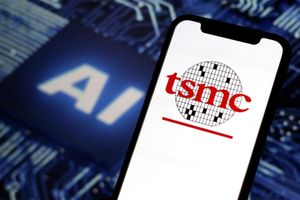
In the relentless pursuit of artificial intelligence (AI) breakthroughs, the spotlight often falls on the dazzling capabilities of large language models (LLMs) and the generative wonders they unleash. Yet, beneath the surface of these computational marvels lies a sophisticated hardware backbone, meticulously engineered to sustain their insatiable demands. At the forefront of this critical infrastructure stands Broadcom Inc. (NASDAQ: AVGO), a semiconductor giant that has quietly, yet definitively, positioned itself as the unseen architect powering the AI supercomputing revolution and shaping the very foundation of next-generation AI infrastructure.
Broadcom's strategic pivot and deep technical expertise in custom silicon (ASICs/XPUs) and high-speed networking solutions are not just incremental improvements; they are foundational shifts that enable the unprecedented scale, speed, and efficiency required by today's most advanced AI models. As of October 2025, Broadcom's influence is more pronounced than ever, underscored by transformative partnerships, including a multi-year strategic collaboration with OpenAI to co-develop and deploy custom AI accelerators. This move signifies a pivotal moment where the insights from frontier AI model development are directly embedded into the hardware, promising to unlock new levels of capability and intelligence for the AI era.
The Technical Core: Broadcom's Silicon and Networking Prowess
Broadcom's critical contributions to the AI hardware backbone are primarily rooted in its high-speed networking chips and custom accelerators, which are meticulously engineered to meet the stringent demands of AI workloads.
At the heart of AI supercomputing, Broadcom's Tomahawk series of Ethernet switches are designed for hyperscale data centers and optimized for AI/ML networking. The Tomahawk 5 (BCM78900 Series), for instance, delivered a groundbreaking 51.2 Terabits per second (Tbps) switching capacity on a single chip, supporting up to 256 x 200GbE ports and built on a power-efficient 5nm monolithic die. It introduced advanced adaptive routing, dynamic load balancing, and end-to-end congestion control tailored for AI/ML workloads. The Tomahawk Ultra (BCM78920 Series) further pushes boundaries with ultra-low latency of 250 nanoseconds at 51.2 Tbps throughput and introduces "in-network collectives" (INC) – specialized hardware that offloads common AI communication patterns (like AllReduce) from processors to the network, improving training efficiency by 7-10%. This innovation aims to transform standard Ethernet into a supercomputing-class fabric, significantly closing the performance gap with specialized fabrics like NVIDIA Corporation's (NASDAQ: NVDA) NVLink. The latest Tomahawk 6 (BCM78910 Series) is a monumental leap, offering 102.4 Tbps of switching capacity in a single chip, implemented in 3nm technology, and supporting AI clusters with over one million XPUs. It unifies scale-up and scale-out Ethernet for massive AI deployments and is compliant with the Ultra Ethernet Consortium (UEC).
Complementing the Tomahawk series is the Jericho3-AI (BCM88890), a network processor specifically repositioned for AI systems. It boasts 28.8 Tbps of throughput and can interconnect up to 32,000 GPUs, creating high-performance fabrics for AI networks with predictable tail latency. Its features, such as perfect load balancing, congestion-free operation, and Zero-Impact Failover, are crucial for significantly shorter job completion times (JCTs) in AI workloads. Broadcom claims Jericho3-AI can provide at least 10% shorter JCTs compared to alternative networking solutions, making expensive AI accelerators 10% more efficient. This directly challenges proprietary solutions like InfiniBand by offering a high-bandwidth, low-latency, and low-power Ethernet-based alternative.
Further solidifying Broadcom's networking arsenal is the Thor Ultra 800G AI Ethernet NIC, the industry's first 800G AI Ethernet Network Interface Card. This NIC is designed to interconnect hundreds of thousands of XPUs for trillion-parameter AI workloads. It is fully compliant with the open UEC specification, delivering advanced RDMA innovations like packet-level multipathing, out-of-order packet delivery to XPU memory, and programmable congestion control. Thor Ultra modernizes RDMA for large AI clusters, addressing limitations of traditional RDMA and enabling customers to scale AI workloads with unparalleled performance and efficiency in an open ecosystem. Initial reactions from the AI research community and industry experts highlight Broadcom's role as a formidable competitor to NVIDIA, particularly in offering open, standards-based Ethernet solutions that challenge the proprietary nature of NVLink/NVSwitch and InfiniBand, while delivering superior performance and efficiency for AI workloads.
Reshaping the AI Industry: Impact on Companies and Competitive Dynamics
Broadcom's strategic focus on custom AI accelerators and high-speed networking solutions is profoundly reshaping the competitive landscape for AI companies, tech giants, and even startups.
The most significant beneficiaries are hyperscale cloud providers and major AI labs. Companies like Alphabet (NASDAQ: GOOGL) (Google), Meta Platforms Inc. (NASDAQ: META), ByteDance, Microsoft Corporation (NASDAQ: MSFT), and reportedly Apple Inc. (NASDAQ: AAPL), are leveraging Broadcom's expertise to develop custom AI chips. This allows them to tailor silicon precisely to their specific AI workloads, leading to enhanced performance, greater energy efficiency, and lower operational costs, particularly for inference tasks. For OpenAI, the multi-year partnership with Broadcom to co-develop and deploy 10 gigawatts of custom AI accelerators and Ethernet-based network systems is a strategic move to optimize performance and cost-efficiency by embedding insights from its frontier models directly into the hardware and to diversify its hardware base beyond traditional GPU suppliers.
This strategy introduces significant competitive implications, particularly for NVIDIA. While NVIDIA remains dominant in general-purpose GPUs for AI training, Broadcom's focus on custom ASICs for inference and its leadership in high-speed networking solutions presents a nuanced challenge. Broadcom's custom ASIC offerings enable hyperscalers to diversify their supply chain and reduce reliance on NVIDIA's CUDA-centric ecosystem, potentially eroding NVIDIA's market share in specific inference workloads and pressuring pricing. Furthermore, Broadcom's Ethernet switching and routing chips, where it holds an 80% market share, are critical for scalable AI infrastructure, even for clusters heavily reliant on NVIDIA GPUs, positioning Broadcom as an indispensable part of the overall AI data center architecture. For Intel Corporation (NASDAQ: INTC) and Advanced Micro Devices, Inc. (NASDAQ: AMD), Broadcom's custom ASICs pose a challenge in areas where their general-purpose CPUs or GPUs might otherwise be used for AI workloads, as Broadcom's ASICs often offer better energy efficiency and performance for specific AI tasks.
Potential disruptions include a broader shift from general-purpose to specialized hardware, where ASICs gain ground in inference due to superior energy efficiency and latency. This could lead to decreased demand for general-purpose GPUs in pure inference scenarios where custom solutions are more cost-effective. Broadcom's advancements in Ethernet networking are also disrupting older networking technologies that cannot meet the stringent demands of AI workloads. Broadcom's market positioning is strengthened by its leadership in custom silicon, deep relationships with hyperscale cloud providers, and dominance in networking interconnects. Its "open ecosystem" approach, which enables interoperability with various hardware, further enhances its strategic advantage, alongside its significant revenue growth in AI-related projects.
Broader AI Landscape: Trends, Impacts, and Milestones
Broadcom's contributions extend beyond mere component supply; they are actively shaping the architectural foundations of next-generation AI infrastructure, deeply influencing the broader AI landscape and current trends.
Broadcom's role aligns with several key trends, most notably the diversification from NVIDIA's dominance. Many major AI players are actively seeking to reduce their reliance on NVIDIA's general-purpose GPUs and proprietary InfiniBand interconnects. Broadcom provides a viable alternative through its custom silicon development and promotion of open, Ethernet-based networking solutions. This is part of a broader shift towards custom silicon, where leading AI companies and cloud providers design their own specialized AI chips, with Broadcom serving as a critical partner. The company's strong advocacy for open Ethernet standards in AI networking, as evidenced by its involvement in the Ultra Ethernet Consortium, contrasts with proprietary solutions, offering customers more choice and flexibility. These factors are crucial for the unprecedented massive data center expansion driven by the demand for AI compute capacity.
The overall impacts on the AI industry are significant. Broadcom's emergence as a major supplier intensifies competition and innovation in the AI hardware market, potentially spurring further advancements. Its solutions contribute to substantial cost and efficiency optimization through custom silicon and optimized networking, along with crucial supply chain diversification. By enabling tailored performance for advanced models, Broadcom's hardware allows companies to achieve performance optimizations not possible with off-the-shelf hardware, leading to faster training times and lower inference latency.
However, potential concerns exist. While Broadcom champions open Ethernet, companies extensively leveraging Broadcom for custom ASIC design might experience a different form of vendor lock-in to Broadcom's specialized design and manufacturing expertise. Some specific AI networking mechanisms, like the "scheduled fabric" in Jericho3-AI, remain proprietary, meaning optimal performance might still require Broadcom's specific implementations. The sheer scale of AI infrastructure build-outs, involving multi-billion dollar and multi-gigawatt commitments, also raises concerns about the sustainability of financing these massive endeavors.
In comparison to previous AI milestones, the shift towards custom ASICs, enabled by Broadcom, mirrors historical transitions from general-purpose to specialized processors in computing. The recognition and address of networking as a critical bottleneck for scaling AI supercomputers, with Broadcom's innovations in high-bandwidth, low-latency Ethernet solutions, is akin to previous breakthroughs in interconnect technologies that enabled larger, more powerful computing clusters. The deep collaboration between OpenAI (designing accelerators) and Broadcom (developing and deploying them) also signifies a move towards tighter hardware-software co-design, a hallmark of successful technological advancements.
The Horizon: Future Developments and Expert Predictions
Looking ahead, Broadcom's trajectory in AI hardware is poised for continued innovation and expansion, with several key developments and expert predictions shaping the future.
In the near term, the OpenAI partnership remains a significant focus, with initial deployments of custom AI accelerators and networking systems expected in the second half of 2026 and continuing through 2029. This collaboration is expected to embed OpenAI's frontier model insights directly into the hardware. Broadcom will continue its long-standing partnership with Google on its Tensor Processing Unit (TPU) roadmap, with involvement in the upcoming TPU v7. The company's Jericho3-AI and its companion Ramon3 fabric chip are expected to qualify for production within a year, enabling even larger and more efficient AI training supercomputers. The Tomahawk 6 will see broader adoption in AI data centers, supporting over one million accelerator chips. The Thor Ultra 800G AI Ethernet NIC will also become a critical component for interconnecting vast numbers of XPUs. Beyond the data center, Broadcom's Wi-Fi 8 silicon ecosystem is designed for AI-era edge networks, including hardware-accelerated telemetry for AI-driven network optimization at the edge.
Potential applications and use cases are vast, primarily focused on powering hyperscale AI data centers for large language models and generative AI. Broadcom's custom ASICs are optimized for both AI training and inference, offering superior energy efficiency for specific tasks. The emergence of smaller reasoning models and "chain of thought" reasoning in AI, forming the backbone of agentic AI, presents new opportunities for Broadcom's XPUs in inference-heavy workloads. Furthermore, the expansion of edge AI will see Broadcom's Wi-Fi 8 solutions enabling localized intelligence and real-time inference in various devices and environments, from smart homes to predictive analytics.
Challenges remain, including persistent competition from NVIDIA, though Broadcom's strategy is more complementary, focusing on custom ASICs and networking. The industry also faces the challenge of diversification and vendor lock-in, with hyperscalers actively seeking multi-vendor solutions. The capital intensity of building new, custom processors means only a few companies can afford bespoke silicon, potentially widening the gap between leading AI firms and smaller players. Experts predict a significant shift to specialized hardware like ASICs for optimized performance and cost control. The network is increasingly recognized as a critical bottleneck in large-scale AI deployments, a challenge Broadcom's advanced networking solutions are designed to address. Analysts also predict that inference silicon demand will grow substantially, potentially becoming the largest driver of AI compute spend, where Broadcom's XPUs are expected to play a key role. Broadcom's CEO, Hock Tan, predicts generative AI could significantly increase technology-related GDP from 30% to 40%, adding an estimated $10 trillion in economic value annually.
A Comprehensive Wrap-Up: Broadcom's Enduring AI Legacy
Broadcom's journey into the heart of AI hardware has solidified its position as an indispensable force in the rapidly evolving landscape of AI supercomputing and next-generation AI infrastructure. Its dual focus on custom AI accelerators and high-performance, open-standard networking solutions is not merely supporting the current AI boom but actively shaping its future trajectory.
Key takeaways highlight Broadcom's strategic brilliance in enabling vertical integration for hyperscale cloud providers, allowing them to craft AI stacks precisely tailored to their unique workloads. This empowers them with optimized performance, reduced costs, and enhanced supply chain security, challenging the traditional reliance on general-purpose GPUs. Furthermore, Broadcom's unwavering commitment to Ethernet as the dominant networking fabric for AI, through innovations like the Tomahawk and Jericho series and the Thor Ultra NIC, is establishing an open, interoperable, and scalable alternative to proprietary interconnects, fostering a broader and more resilient AI ecosystem. By addressing the escalating demands of AI workloads with purpose-built networking and custom silicon, Broadcom is enabling the construction of AI supercomputers capable of handling increasingly complex models and scales.
The overall significance of these developments in AI history is profound. Broadcom is not just a supplier; it is a critical enabler of the industry's shift towards specialized hardware, fostering competition and diversification that will drive further innovation. Its long-term impact is expected to be enduring, positioning Broadcom as a structural winner in AI infrastructure with robust projections for continued AI revenue growth. The company's deep involvement in building the underlying infrastructure for advanced AI models, particularly through its partnership with OpenAI, positions it as a foundational enabler in the pursuit of artificial general intelligence (AGI).
In the coming weeks and months, readers should closely watch for further developments in the OpenAI-Broadcom custom AI accelerator racks, especially as initial deployments are expected in the latter half of 2026. Any new custom silicon customers or expansions with existing clients, such as rumored work with Apple, will be crucial indicators of market traction. The industry adoption and real-world performance benchmarks of Broadcom's latest networking innovations, including the Thor Ultra NIC, Tomahawk 6, and Jericho4, in large-scale AI supercomputing environments will also be key. Finally, Broadcom's upcoming earnings calls, particularly the Q4 2025 report expected in December, will provide vital updates on its AI revenue trajectory and future outlook, which analysts predict will continue to surge. Broadcom's strategic focus on enabling custom AI silicon and providing leading-edge Ethernet networking positions it as an indispensable partner in the AI revolution, with its influence on the broader AI hardware landscape only expected to grow.
This content is intended for informational purposes only and represents analysis of current AI developments.
TokenRing AI delivers enterprise-grade solutions for multi-agent AI workflow orchestration, AI-powered development tools, and seamless remote collaboration platforms.
For more information, visit https://www.tokenring.ai/.





